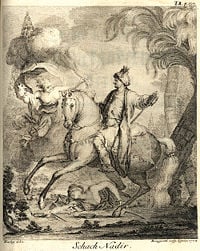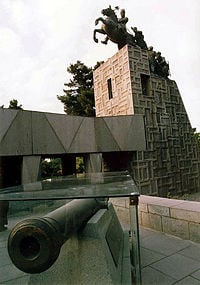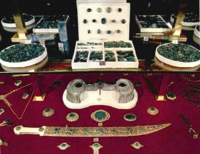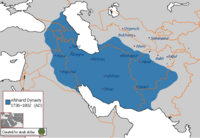Nader Shah
| Nader Shah | ||
|---|---|---|
| King of Persia | ||
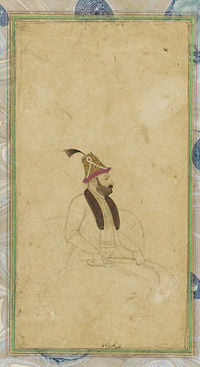
| ||
| Reign | 1736â1747 | |
| Born | August 6, 1698 | |
| Died | June 19, 1747 | |
| Predecessor | Abbas III | |
| Successor | Adil Shah | |
NÄder ShÄh AfshÄr (Persian: Ùادر شا٠اÙشار; also known as NÄder Qoli Beg - Ùادر ÙÙÛ Ø¨ÛÚ¯ or TahmÄsp Qoli KhÄn - تÙ٠اسپ ÙÙÛ Ø®Ø§Ù) (November 1688[1] â June 19, 1747) ruled as Shah of Iran (1736â47) and was the founder of the Afsharid dynasty. Because of his military genius, some historians have described him as the Napoleon of Persia[2] or the Second Alexander.[3] Nader Shah was a member of the Turkmen Afshar tribe of northern Persia,[4] which had supplied military power to the Safavid state since the time of Shah Ismail I.[5]
Nader rose to power during a period of anarchy in Persia after a rebellion by Afghans had overthrown the weak Shah Soltan Hossein and both the Ottomans and the Russians had seized Persian territory for themselves. Nader reunited the Persian realm and removed the invaders. He became so powerful that he decided to depose the last members of the Safavid dynasty, which had ruled Persia for over 200 years, and become shah himself in 1736. His campaigns created a great Iranian Empire that briefly encompassed what is now Iran, Afghanistan, Pakistan, parts of the Caucasus region, and parts of Central Asia, but his military spending had a ruinous effect on the Persian economy.[6] Nader idolized Genghis Khan and Timur, the previous conquerors from Central Asia. Nader imitated their military prowess andâespecially later in his reignâtheir cruelty. Nader Shah's victories briefly made him the Middle East's most powerful sovereign, but his empire quickly disintegrated after he was assassinated in 1747. Nader Shah has been described as "the last great Asian military conqueror."[7] He is credited with restoring Iranian prestige especially as an alternative power in the region to the larger Ottoman Empire.[8] On the one hand, his defeat of the Moghul Empire allowed the British to dominate India within the next half-century. On the other-hand, his restoration of Persian prestige helped those who succeeded him to maintain political independence. Economically, though, Persia became too weak to prevent the Russians, the British, and later the U.S. from carving out their spheres of influence. His ruthlessness resulted in his murder. Lacking a firm organizational base to sustain the dynasty he founded, this was a short-lived lineage.
Early life
Nader Shah was born in Dastgerd[9] into the Qereqlu clan of the Afshars, a semi-nomadic tribe in Khorasan, a province in the north-east of the Persian Empire. His father, a poor peasant, died while Nader was still a child. According to legends, Nader and his mother were carried off as slaves by marauding Uzbek or Turkmen tribesmen, but Nader managed to escape. He joined a band of brigands while still a boy and eventually became their leader. Under the patronage of Afshar chieftains, he rose through the ranks to become a powerful military figure. Nader married the two daughters of Baba Ali Beg, a local chief.
The fall of the Safavid dynasty
Nader grew up during the final years of the Safavid dynasty which had ruled Persia since 1502. At its peak, under such figures as Abbas the Great, Safavid Persia had been a powerful empire, but by the early eighteenth century the state was in serious decline and the reigning shah, Soltan Hossein, was a weak ruler. When Soltan Hussein attempted to quell a rebellion by Ghilzai Afghans in Kandahar, the governor he sent was killed. Under their leader Mahmud, the rebellious Afghans moved westwards against the shah himself and in 1722 they defeated a vastly superior force at the Battle of Golnabad and then besieged the capital, Isfahan. After the shah failed to escape to rally a relief force elsewhere, the city was starved into submission and Soltan Hussein abdicated, handing power to Mahmud. In Khorasan, Nader at first submitted to the local Afghan governor of Mashhad, Malek Mahmud, but then rebelled and built up his own small army. Soltan Hosseinâs son had declared himself Shah Tahmasp II, but found little support and fled to the Qajar tribe, who offered to back him. Meanwhile, Persia's imperial rivals, the Ottomans and the Russians, took advantage of the chaos in the country to seize territory for themselves.[10]
Defeat of the Afghans
Tahmasp and the Qajar leader Fath Ali Khan (the ancestor of Agha Mohammad Khan Qajar) contacted Nader and asked him to join their cause and drive the Afghans out of Khorasan. He agreed and thus became a figure of national importance. When Nader discovered that Fath Ali Khan was in treacherous correspondence with Malek Mahmud and revealed this to the shah, Tahmasp executed him and made Nader the chief of his army instead. Nader subsequently took on the title Tahmasp Qoli (Servant of Tahmasp). In late 1726, Nader recaptured Mashhad.[11]
Nader chose not to march directly on Isfahan. First, in May 1729, he defeated the Abdali Afghans near Herat. Many of the Abdali Afghans subsequently joined his army. The new Ghilzai Afghan shah, Ashraf, decided to move against Nader but in September 1729, Nader defeated him at the Battle of Damghan and again, decisively, in November at Murchakhor. Ashraf fled and Nader finally entered Isfahan, handing it over to Tahmasp in December. The citizens' rejoicing was cut short when Nader plundered them to pay his army. Tahmasp made Nader governor over many eastern provinces, including his native Khorasan, and married him to his sister. Nader pursued and defeated Ashraf, who was murdered by his own followers.[12] In 1738 Nader Shah besieged and destroyed Kandahar. This was the ultimate defeat of any remaining Afghan forces. Nader Shah built a new city near Kandahar, which he named Naderabad.
Ottoman campaign
In the spring of 1730, Nader attacked the Ottomans and regained most of the territory lost during the recent chaos. At the same time, the Abdali Afghans rebelled and besieged Mashhad, forcing Nader to suspend his campaign and save his brother, Ebrahim. It took Nader fourteen months to defeat the Abdali Afghans.
Relations between Nader and the Shah had declined as the latter grew jealous of his general's military successes. While Nader was absent in the east, Tahmasp tried to assert himself by launching a foolhardy campaign to recapture Yerevan. He ended up losing all of Naderâs recent gains to the Ottomans, and signed a treaty ceding Georgia and Armenia in exchange for Tabriz. Nader saw that the moment had come to ease Tahmasp from power. He denounced the treaty, seeking popular support for a war against the Ottomans. In Isfahan, Nader got Tahmasp drunk then showed him to the courtiers asking if a man in such a state was fit to rule. In 1732, he forced Tahmasp to abdicate in favor of the Shahâs baby son, Abbas III, to whom Nader became regent.
Nader decided he could win back the territory in Armenia and Georgia by seizing Ottoman Baghdad and then offering it in exchange for the lost provinces, but his plan went badly amiss when his army was routed by the Ottoman general Topal Osman Pasha near the city in 1733. Nader decided he needed to regain the initiative as soon as possible to save his position because revolts were already breaking out in Persia. He faced Topal again with a larger force and defeated and killed him. He then besieged Baghdad, as well as Ganja in the northern provinces, earning a Russian alliance against the Ottomans. Nader scored a great victory over a superior Ottoman force at Baghavard and by the summer of 1735, Persian Armenia and Georgia were his again. In March 1735, he signed a treaty with the Russians in Ganja by which the latter agreed to withdraw all of their troops from Persian territory.[13]
Nader becomes shah
In January 1736, Nader held a qoroltai (a grand meeting in the tradition of Genghis Khan and Timur) on the Moghan Plain in Azerbaijan. The leading figures in Persian political and religious life attended. Nader suggested he should be proclaimed the new shah in place of the young Abbas III. Everyone agreed, manyâif not mostâenthusiastically, the rest fearing Naderâs anger if they showed support for the deposed Safavids. Nader was crowned Shah of Iran on March 8, 1736, a date his astrologers had chosen as being especially propitious.[14]
Religious policy
Nader also proposed religious reforms. The Safavids had introduced Shi'a Islam as the state religion of Persia. Nader believed this had intensified the conflict with the Ottoman Empire which was Sunni. His own army was also a mixture of Sunni and Shi'a Muslims. He wanted Persia to adopt a form of religion that would be more acceptable to Sunnis and suggested Persia should adopt a form of Shi'ism he called "Ja'fari" in honor of the sixth Shi'a imam Ja'far al-Sadiq. He banned certain Shi'a practices which were particularly offensive to Sunnis, such as the cursing of the first three caliphs. Nader hoped that "Ja'farism" would be accepted as a fifth school (mazhab) of Sunni Islam and that the Ottomans would allow its adherents to go on the hajj, or pilgrimage, to Mecca, which was within their territory. In the subsequent peace negotiations, the Ottomans refused to acknowledge Ja'farism as a fifth mazhab but they did allow Persian pilgrims to go on the hajj. Nader was interested in gaining rights for Persians to go on the hajj in part because of revenues from the pilgrimage trade. Nader's other primary aim in his religious reforms was to weaken the Safavids further since Shi'a Islam had always been a major element in support for the dynasty. He had the chief mullah of Persia strangled after he was heard expressing support for the Safavids. Among his reforms was the introduction of what came to be known as the kolah-e Naderi. This was a hat with four peaks which symbolized the first four caliphs.[15]
Invasion of India
In 1738, Nader Shah conquered Kandahar, the last outpost of the Ghilzai Afghans. His thoughts now turned to Mughal India to the south. This once powerful Muslim state was falling apart as the nobles became increasingly disobedient and the Hindu Marathas made inroads on its territory from the south-west. Its ruler Mohammed Shah was powerless to reverse this disintegration. Nader used the pretext of his Afghan enemies taking refuge in India to cross the border and capture Kabul, Ghazni, and Lahore. He then advanced deeper into India crossing the river Indus before the end of year. He defeated the Mughal army at the huge Battle of Karnal in February 1739. After this victory, Nader captured Mohammad Shah and entered with him into Delhi. When a rumor broke out that Nader had been assassinated, some of the Indians attacked and killed Persian troops. Nader reacted by ordering his soldiers to massacre the population and plunder the city. During the course of one day (March 22) 20,000 to 30,000 Indians were killed by the Persian troops, forcing Mohammad Shah to beg for mercy.[16] In response, Nader Shah agreed to withdraw, but Mohammad Shah paid the consequence in handing over the keys of his royal treasury, and losing even the Peacock Throne to the Persian emperor. The Peacock Throne thereafter served as a symbol of Persian imperial might. Among a trove of other fabulous jewels, Nader also gained the Koh-i-Noor and Darya-ye Noor diamonds (Koh-i-Noor means "Mountain of Light" in Persian, Darya-ye Noor means "Sea of Light"). The Persian troops left Delhi at the beginning of May 1739. Nader's soldiers also took with them thousands of elephants, horses, and camels, loaded with the booty they had collected. The plunder seized from India was so rich that Nader stopped taxation in Iran for a period of three years following his return.[17] The Mughal empire was left impoverished, and effectively this defeat marked the end of Mughal supremacy. Before the end of the century, the Mughals were living on a British pension in Dehli, with only the trappings of power.
After India
The Indian campaign was the zenith of Nader's career. Afterwards he became increasingly despotic as his health declined markedly. Nader had left his son Reza Qoli Mirza to rule Persia in his absence. Reza had behaved highhandedly and somewhat cruelly but he had kept the peace in Persia. Having heard rumors that his father had died, he had made preparations for assuming the crown. These included the murder of the former shah Tahmasp and his family, including the nine-year old Abbas III. On hearing the news, Rezaâs wife, who was Tahmaspâs sister, committed suicide. Nader was not impressed with his sonâs waywardness and reprimanded him, but he took him on his expedition to conquer territory in Transoxiana. After the Persians had forced the Uzbek khanate of Bokhara to submit, Nader wanted Reza to marry the khanâs elder daughter because she was a descendant of his hero Genghis Khan, but Reza flatly refused and Nader married the girl himself. Nader also conquered Khwarezm on this expedition into Central Asia.
Nader now decided to punish Daghestan for the death of his brother Ebrahim Qoli on a campaign a few years earlier. In 1741, while Nader was passing through the forest of Mazanderan on his way to fight the Daghestanis, an assassin took a shot at him but Nader was only lightly wounded. He began to suspect his son was behind the attempt and confined him to Tehran. Naderâs increasing ill health made his temper ever worse. Perhaps it was his illness that made Nader lose the initiative in his war against the Lezgin tribes of Daghestan. Frustratingly for him, they resorted to guerrilla warfare and the Persians could make little headway against them. Nader accused his son of being behind the assassination attempt in Mazanderan. Reza angrily protested his innocence, but Nader had him blinded as punishment, although he immediately regretted it. Soon afterward, Nader started executing the nobles who had witnessed his son's blinding. In his last years, Nader became increasingly paranoid, ordering the assassination of large numbers of suspected enemies.
With the wealth he gained from India, Nader started to build a Persian navy. With lumber from Mazandaran, he built ships in Bushehr. He also purchased thirty ships in India. He recaptured the island of Bahrain from the Arabs. In 1743, he conquered Oman and its main capital the city of Muscat. In 1743, Nader started another war against the Ottoman Empire. Despite having a huge army at his disposal, in this campaign Nader showed little of his former military brilliance. It ended in 1746 with the signing of a peace treaty, in which the Ottomans agreed to let Nader occupy Najaf.[18]
Domestic policies
Nader changed the Iranian coinage system. He minted silver coins, called Naderi, that were equal to the Mughal rupee. Nader discontinued the policy of paying soldiers based on land tenure. Like the late Safavids he resettled tribes. Nader Shah transformed the Shahsevan, a nomadic group living around Azerbaijan whose name literally means "shah lover," into a tribal confederacy which defended Iran against the Ottomans and Russians.[19][20] In addition, he increased the number of soldiers under his command and reduced the number of soldiers under tribal and provincial control.
Death and legacy
Nader became crueler and crueler as a result of his illness and his desire to extort more and more tax money to pay for his military campaigns. More and more revolts broke out and Nader crushed them ruthlessly, building towers from his victimsâ skulls in imitation of his hero Timur. In 1747, Nader set off for Khorasan where he intended to punish Kurdish rebels. Some of his officers feared he was about to execute them and plotted against him. Nader Shah was assassinated on June 19, 1747, at Fathabad in Khorasan. He was surprised in his sleep by Salah Bey, captain of the guards, and stabbed with a sword. Nader was able to kill two of the assassins before he died.
After his death, he was succeeded by his nephew Ali Qoli, who renamed himself Adil Shah ("righteous king"). Adil Shah was probably involved in the assassination plot.[21] Adil Shah was deposed within a year. During the struggle between Adil Shah, his brother Ibrahim Khan and Nader's grandson Shah Rukh almost all provincial governors declared independence, established their own states, and the entire Empire of Nader Shah fell into anarchy. Nader Shah, for all his brilliance, did not establish a sufficiently strong administrative base on which his heirs could sustain the dynasty. He had kept power firmly in his own hands. Finally, Karim Khan founded the Zand dynasty and became ruler of Iran by 1760, while Ahmad Shah Durrani, himself a protégé of Nader Shah, had already proclaimed independence in the east, marking the foundation of modern Afghanistan. Ahmad Shah Durrani invaded India nine times, reducing the Moghul Emperor, Alamgir II to a vassal. His son, Shah Alam II became the first Moghul to live as a pensioner of the British (1803-1805).
Nader Shah was well known to the European public of the time. In 1768, Christian VII of Denmark commissioned Sir William Jones to translate a Persian language biography of Nader Shah written by his Minister Mirza Mehdi Khan Astarabadi into French.[22] It was published in 1770 as Histoire de Nadir Chah.[23] Nader's Indian campaign alerted the British East India Company to the extreme weakness of the Mughal Empire and the possibility of expanding to fill the power vacuum. Without Nader, "eventual British rule [in India] would have come later and in a different form, perhaps never at allâwith important global effects."[24] On the other hand, his restoration of Persia's own military capability helped to ensure that while the surrounding nations all became, at some point, European colonies or mandated territories, Persia remained independent even if later Shahs all but surrendered power to the Western oil-companies (which were owned or part-owned by governments.) Obviously a gifted leader, in the end it was his personality that led to his murder. His heirs were unable to maintain the dynasty, perhaps lacking his ruthlessness.
Dynasty
Nader Shah (1737-1747) Ali Gholi (1747-1748) Ebrahim (1748) Shahrokh (1748-1796)
| Preceded by: Abbas III |
King of Persia 1736â1747 |
Succeeded by: Adel Shah Afshar |
Notes
- â Axworthy (2006), 17.
- â Axworthy (2006), xvii
- â xs4all.nl, Nadir Shah of Persia. Retrieved June 15, 2008.
- â Axworthy (2006), 17-19.
- â Stephen Erdely and Valentin A. Riasanovski, The Uralic and Altaic Series (London, UK: Routledge, 1997, ISBN 0700703802), 102.
- â Ernest Tucker, NAÃDER SHAH 1736-47, Encyclopedia Iranica. Retrieved June 15, 2008.
- â Avery, et al., (1991), 59.
- â Nasr, Vali, The Shia Revival: How Conflicts within Islam Will Shape the Future (New York, NY: Norton, 2006, ISBN 9780393062113), 80.
- â Axworthy (2006), 18.
- â Axworthy (2006), 17-56.
- â Axworthy (2006), 57-74.
- â Axworthy (2006), 75-116
- â Daniel (2001), 94
- â Axworthy (2006), 137-174.
- â Axworthy (2006), 137-174.
- â Axworthy (2006), 8.
- â Axworthy (2006), 1-16, 175-210.
- â Axworthy (2006), 175-274.
- â Willem Floor, Book review of Richard Tapper's "Frontier Nomads of Iran: A Political and Social History of the Shahsevan," Journal of the American Oriental Society 119 (3): 543.
- â Daniel (2001), 90.
- â Daniel (2001), 94.
- â Encyclopedia Britannica, 1911, Sir William Jones. Retrieved June 15, 2008.
- â Axworthy (2006), 330.
- â Axworthy (2006), xvi.
ReferencesISBN links support NWE through referral fees
- Avery, Peter, Gavin Hambly, and C. P. Melville. 1991. The Cambridge history of Iran: From Nadir Shah to the Islamic Republic, Vol 7. Cambridge, UK: University Press. ISBN 9780521200950.
- Axworthy, Michael. 2006. The Sword of Persia: Nader Shah, from Tribal Warrior to Conquering Tyrant. London, UK: I. B. Tauris. ISBN 1-85043-706-8.
- Axworthy, Michael. 2008. A History of Iran: Empire of the Mind. New York, NY: Basic Books. ISBN 9780465008889.
- Daniel, Elton L. 2001. The History of Iran. The Greenwood histories of the modern nations. Westport, CT: Greenwood Press. ISBN 9780313307317.
- Tucker, Ernest. 2006. Nadir Shah's Quest for Legitimacy in Post-Safavid Iran. Gainesville, FL: University Press of Florida. ISBN 0-8130-2964-3.
External links
All links retrieved June 2, 2025.
- Nader Shah's portrait.
- History of Iran: Afsharid Dynasty (Nader Shah).
- Nader Shah Mausoleum and Museum.
Credits
New World Encyclopedia writers and editors rewrote and completed the Wikipedia article in accordance with New World Encyclopedia standards. This article abides by terms of the Creative Commons CC-by-sa 3.0 License (CC-by-sa), which may be used and disseminated with proper attribution. Credit is due under the terms of this license that can reference both the New World Encyclopedia contributors and the selfless volunteer contributors of the Wikimedia Foundation. To cite this article click here for a list of acceptable citing formats.The history of earlier contributions by wikipedians is accessible to researchers here:
The history of this article since it was imported to New World Encyclopedia:
Note: Some restrictions may apply to use of individual images which are separately licensed.
